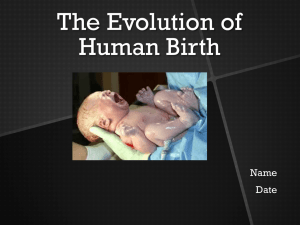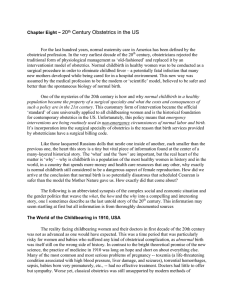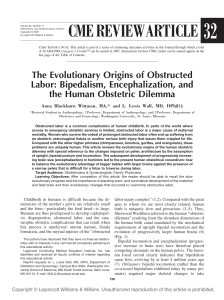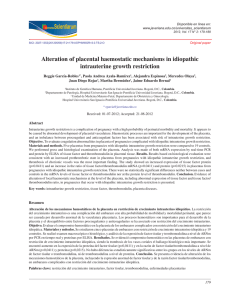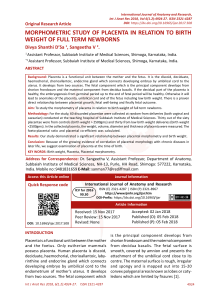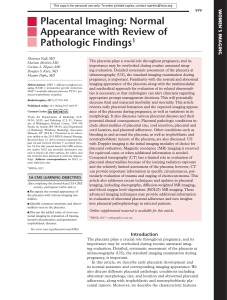The Stages of Labor 2nd Edition Facilitator`s Guide With Handouts
Anuncio
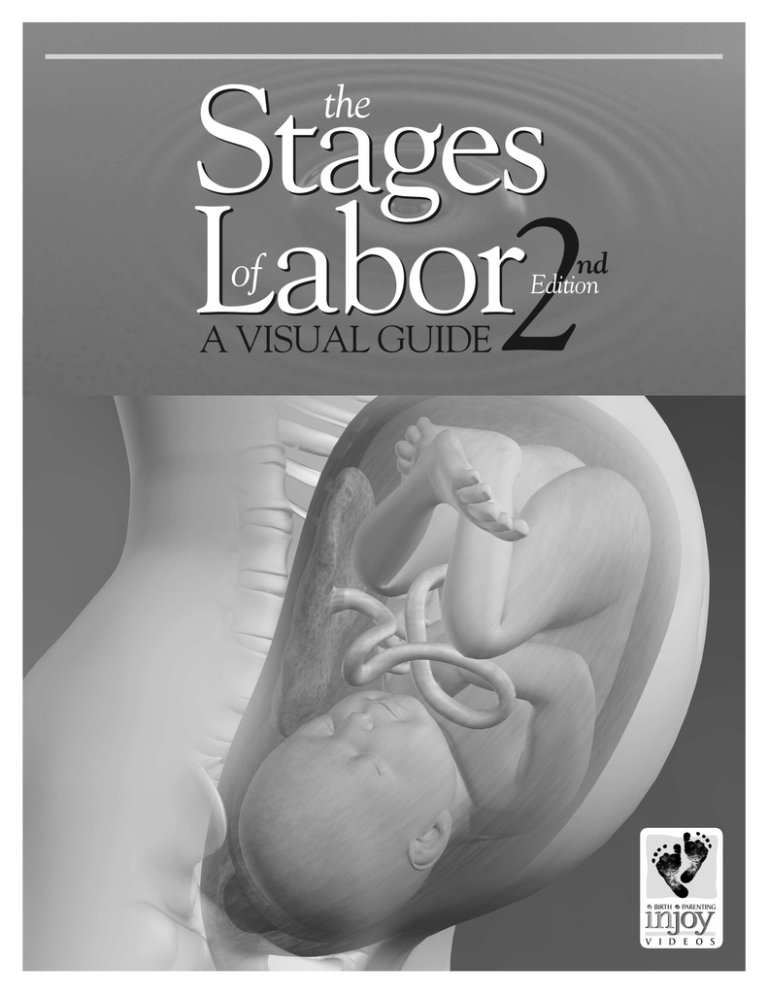
Stages Labor2 the of A VISUAL GUIDE nd Edition Stages Labor2 the of nd Edition A VISUAL GUIDE INTRODUCTION Childbirth is a miraculous process that is fascinating to study. Students will be amazed to learn how the human body accommodates childbirth, such as the cervix opening to 10 centimeters and a baby’s skull plates molding together to fit through the birth canal. Whether your students are expectant parents, or simply studying childbirth in class, this program educates students about the amazing process of birth. State-of-the-art animation makes the birthing process easy to understand as parents talk personally about the emotional journey of labor. This video may be one of the best teaching tools for students of any age who are about to take a similar journey themselves. Any viewer will appreciate this realistic, thorough program. This guide will help you adapt this video to your particular uses, so that your students will get the most out of The Stages of Labor 2nd Edition: A Visual Guide. FACILITATOR GUIDE CONTENTS Suggested Uses. . . . . . . . . . . . . . . . . . . . . . . . . . . . . . . . . . . . . . . . . . . . . . . . . . . . . . . . . . . . . . . . Page 2 Provided Materials. . . . . . . . . . . . . . . . . . . . . . . . . . . . . . . . . . . . . . . . . . . . . . . . . . . . . . . . . . . . . Page 2 Audience Objectives . . . . . . . . . . . . . . . . . . . . . . . . . . . . . . . . . . . . . . . . . . . . . . . . . . . . . . . . . . . Page 2 Facilitator Preparation. . . . . . . . . . . . . . . . . . . . . . . . . . . . . . . . . . . . . . . . . . . . . . . . . . . . . . . . . . Page 2 Program Overview. . . . . . . . . . . . . . . . . . . . . . . . . . . . . . . . . . . . . . . . . . . . . . . . . . . . . . . . . . . . . Page 3 Discussion Topics Prior to Viewing . . . . . . . . . . . . . . . . . . . . . . . . . . . . . . . . . . . . . . . . . . . . . . . . Page 4 Discussion Topics After Viewing. . . . . . . . . . . . . . . . . . . . . . . . . . . . . . . . . . . . . . . . . . . . . . . . . . Page 5 Vocabulary Exercise. . . . . . . . . . . . . . . . . . . . . . . . . . . . . . . . . . . . . . . . . . . . . . . . . . . . . . . . . . . . Page 6 Vocabulary Exercise (Spanish) . . . . . . . . . . . . . . . . . . . . . . . . . . . . . . . . . . . . . . . . . . . . . . . . . . . Page 7 Vocabulary Answer Key . . . . . . . . . . . . . . . . . . . . . . . . . . . . . . . . . . . . . . . . . . . . . . . . . . . . . . . . Page 8 Follow-Up Activities. . . . . . . . . . . . . . . . . . . . . . . . . . . . . . . . . . . . . . . . . . . . . . . . . . . . . . . . . . . Page 9 1 © 2006 InJoy Productions, Inc. All rights reserved. 800-326-2082 injoyvideos.com SUGGESTED USES FOR PROGRAM This video is intended for use in secondary schools, teen pregnancy groups, clinics, and hospitals. The two target audiences of this program are 1) expectant parents, including pregnant teens and 2) students studying biology, anatomy, health, or Family and Consumer Science. PROVIDED MATERIALS G Videotape or DVD (Length: 30 minutes) G Facilitator’s Guide AUDIENCE OBJECTIVES After viewing the video and participating in the activities, your audience should be able to: G Understand the anatomy of pregnancy; G Differentiate between the signs of pre-labor and the onset of labor; G Explain the distinction between the three stages of labor; G Explain how the cervix dilates and effaces during each stage of labor; G Describe the typical emotions during each stage; G Identify the average time lengths for each stage of labor; G Understand how the baby moves through the pelvis and birth canal during second stage; G List different ways parents can cope with the challenges of childbirth during each stage. SUGGESTED FACILITATOR PREPARATION G Review the video and facilitator’s guide; G Facilitate a group discussion based on the Discussion Questions Prior to Viewing (pg. 4); G Present the video, stopping it in sections when needed; G Facilitate a group discussion based on the Discussion Questions After Viewing (pg. 5); G Prepare the Vocabulary Exercise for students (pg. 6, pg. 7 Spanish); G Involve students in the Vocabulary Exercise (pg. 6, pg. 7 Spanish); G Involve students in the Follow-up Activities (pg. 9). Feel free to tailor any part of the presentation to fit your particular needs. FAMILY NOTES To facilitate an organized class discussion, it may help to refer to the different families in the program. G Katie and Aaron (younger couple, Caucasian) G Becky and Jay (couple in their early thirties, Caucasian) G Cynthia and Martin (couple in their late twenties, African-American) G Anita (single Asian-American mother, 33 years old) 2 © 2006 InJoy Productions, Inc. All rights reserved. 800-326-2082 injoyvideos.com PROGRAM OVERVIEW other relaxation techniques • Internal rotation INTRODUCTION ANATOMY OF PREGNANCY • Uterus • Cervix • Mucous plug • Birth canal/vagina • Placenta • Umbilical cord • Bag of waters/amniotic sac FIRST STAGE: TRANSITION • Length: 30 minutes - 2 hours • Contractions: 1-3 minutes apart, 60-90 seconds each • Cervical dilation: 7-10 cm • Emotions: irritability, disorientation, dependent on others • Labor support: help mom focus with direct eye contact, use to-the-point instructions, emotional support PRE-LABOR SIGNS • Warm-up contractions and pre-term labor alert • Lightening/engagement • Passing of the mucous plug • Nesting instinct • Flu-like symptoms SECOND STAGE • Cervical dilation complete • Length: 20 minutes - 3 hours • Contractions: 3-5 minutes apart, 45 to 90 seconds each • Emotions: overwhelming mix, exhaustion, second wind, excitement • Labor support: help mom change into positions, provide focus and emotional support, remind her to rest between pushes • Descent, pelvic station, bony plates • Crowning • Birth (including cardinal movements of baby) • Cutting the umbilical cord ONSET OF LABOR • Regular contractions • Breaking of the waters THE THREE STAGES OF LABOR (OVERVIEW) • First stage – dilation of cervix • Second stage – birth of baby • Third stage – delivery of placenta and involution FIRST STAGE: OVERVIEW OF PHASES FIRST STAGE: EARLY LABOR • Cervical dilation: 0-3 centimeters • Contractions: how to time, 5-30 minutes apart, 30-45 seconds each • Length: 6-12 hours • Emotions: excitement, joy • Labor support: help mom sleep/rest, go on easy walk, or other light activity THIRD STAGE • Delivery of the placenta: 5-20 minutes after birth • Emotions: relief, joy, fatigue • Involution • Breastfeeding CONCLUSION FIRST STAGE: ACTIVE LABOR • Length: 3-5 hours • Contractions: 3-5 minutes apart, duration 45-60 seconds each, may cause spotting • Cervical dilation: 3-7 centimeters • Emotions: more serious concentration on labor, need for emotional support, wavering selfconfidence • Labor support: provide encouragement, suggest and help with position changes and 3 © 2006 InJoy Productions, Inc. All rights reserved. 800-326-2082 injoyvideos.com DISCUSSION QUESTIONS PRIOR TO VIEWING 1. What images do you have of labor and childbirth? Where do these images come from? It’s interesting to see what kind of images students get from the media because labor and childbirth are seldom represented in a realistic way. 2. Have you ever attended or seen an actual birth? This will help you gauge how much your class may know, or what they expect to see during the program. 3. How long do you think labor lasts? Students may be surprised to learn that labor lasts an average of 6 to 24 hours, and can be much longer. 4. What are some signs that a woman might be in labor? Students may know from the media, other parents, or personal experience that the breaking of the waters or regular contractions signal to a woman that her labor is beginning. 5. What is a contraction and what does it do? Students have probably heard the word “contraction” associated with labor many times, but not realize that it is referring to the muscular uterus contracting to open the cervix and to push the baby down and out the birth canal. 6. How do you think labor and childbirth affects a woman emotionally? Childbirth is not only a physical journey, but an emotional one as well. It may be interesting to see how the males and females in the class respond differently to this question. 7. How does labor and childbirth affect a woman physically? A woman’s body goes through many changes during labor. Her cervix effaces and dilates, her uterus contracts and shrinks after birth, the birth canal stretches so the baby fits through, etc. 8. What might parents do to get ready for the birth of a baby? A woman visits her healthcare provider frequently during pregnancy, she and her birth companion may take childbirth and breastfeeding classes, and visit the hospital maternity ward. They may also create a birth plan that helps them plan their own unique labor and birth experience. They need to create a safe, comfortable environment at home for when the new baby leaves the hospital. 4 © 2006 InJoy Productions, Inc. All rights reserved. 800-326-2082 injoyvideos.com DISCUSSION QUESTIONS AFTER VIEWING 1. How did your initial images of childbirth compare with what you saw in the video? Discuss whether your students’ images of childbirth before watching the video were accurate. 2. How do the different pre-labor signs help a mother to get ready for actual labor? Does this mean that she is in labor? Warm-up contractions help to strengthen the uterus for labor, lightening prepares the baby’s position, flu-like symptoms clean out a pregnant woman’s system, the nesting instinct helps her to prepare for the baby, and the passing of the mucous plug opens the cervix. These signs do not mean that labor is beginning, but signal to the mother that labor is approaching. 3. What is the most common way that labor begins? Usually, with regular contractions, sometimes with the breaking of the waters. 4. What are the stages of labor and how are they different? First stage labor is divided up according to cervical dilation and length and duration of contractions. Second stage involves pushing and birth, and third stage is the delivery of the placenta. 5. What were some of the emotional milestones associated with the different stages of labor? Why do you think the woman would feel that way? Joy, concentration, relief, irritability, exhaustion, etc. A woman may experience emotional changes during labor that reflect the physical challenges and changes her body is going through. 6. How does the baby move during labor to aid the birth process? During pre-labor, the baby drops into the pelvis. During active labor, most babies turn to the anterior position, facing their mothers’ backs. This position and the baby’s molding skull plates help to ease descent and delivery. 7. Why must a mother deliver the placenta after birth? Why does the doctor/midwife check it? The placenta is an organ that is created during pregnancy and supports the fetus. After delivery, the placenta is no longer needed. The doctor or midwife checks to be sure the entire organ has been expelled. 8. Have students discuss how this video has affected their views of sexuality and body image. 5 © 2006 InJoy Productions, Inc. All rights reserved. 800-326-2082 injoyvideos.com VOCABULARY EXERCISE Have students fill in the blanks. You may want to write the word list options on the board or overhead for students to guess from. 1. A baby lives inside of his or her mother’s ________, a strong balloon-shaped muscle that contracts during labor. 2. A mother’s ________ must _________ to 10 centimeters so that her baby can be born. It must also completely __________, which means to thin out. 3. A baby turns and drops further down in the pelvis before labor begins, usually during the last month of pregnancy. This is called _________________. 4. When a pregnant woman feels like she has to immediately prepare for the baby, possibly by cleaning the house or setting up the crib, she may be experiencing the _________ ________, which is a sign of pre-labor. 5. If the bag of waters, or ___________ _______ breaks, a woman can expect to be in active labor within 24 hours. 6. Forceful _____________, occurring at regular intervals during labor push the baby further down in the pelvis. 7. When babies turn inside the pelvis during active labor it is called ___________ ___________ . Most babies turn to face their mothers’ backs, called the __________ position. If they turn and face their mothers’ fronts, they are in the ____________ position, which may cause a longer, more difficult labor. 8. The baby’s position relative to the spines of the pelvis is called _______ ____________. 9. Babies skulls are made up of five separate __________ _________ that mold together to help them fit through the birth canal, or the _____________, for birth. 10. A baby’s head ____________ at the +3 or +4 pelvic station, when it no longer slips back between contractions. 11. The __________ _________ is clamped and cut after birth because it no longer supplies the baby with food and oxygen. 12. The third stage of labor is marked by the delivery of the ____________, a special organ created specifically for pregnancy. 13. Breastfeeding speeds the process of ______________, when the uterus contracts and shrinks. 6 © 2006 InJoy Productions, Inc. All rights reserved. Permission to copy granted. EJERCICIO DE VOCABULARIO Las Etapas del Parto: Una Guía Visual Por favor llena el espacio con el término apropiado. 1. El bebé vive dentro del ________________ de su madre, un músculo fuerte con forma de globo que se contrae durante el parto. 2. El _________ de la madre debe __________10 centímetros para que pueda nacer su bebé. También debe ____________ completamente, lo cual quiere decir estirarse hasta ser muy delgado. 3. El bebé gira y baja todavía más dentro de la pelvis antes de que empiece el trabajo de parto, generalmente durante el último mes del embarazo. A esto se le llama _________________. 4. Cuando una mujer embarazada siente que tiene que preparar todo para la llegada inminente del bebé, posiblemente limpiando su casa o armando la cuna, es posible que esté sintiendo ___________________________, lo cual es una señal de pre-parto. 5. Si la fuente, o ___________ _______________ se rompe, la madre puede contar con que estará en trabajo de parto activo en espacio de 24 horas. 6. Fuertes ____________________ ocurren a intérvalos regulares durante el trabajo de parto, y empujan al bebé a través de la pelvis. 7. La _____________ _______________ ocurre cuando los bebés giran dentro de la pelvis durante el trabajo de parto activo. La mayor parte de los bebés giran para estar de cara a la espalda de su madre, lo que se llama la posición _________________. Si giran y quedan de cara hacia el frente de su madre, toman la posición ___________________, lo cual puede ocasionar un parto más largo y difícil. 8. La posición del bebé en relación a las espinas de la pelvis se llama ___________ _________. 9. Los cráneos de los bebés están compuestos de cinco ___________ ____________ que se amoldan para ayudar su pasaje a través del canal de parto o ______________ para nacer. 10. La cabeza del bebé ________________ cuando llega a la estación pélvica +3 o +4 y ya no retrocede entre las contracciones. 11. El ____________ ________________ se pinza y corta después del nacimiento porque ya no le proporciona al bebé oxígeno y alimentación. 12. La Tercera Etapa del parto se define por la expulsión de la _______________, un órgano especial creado específicamente para el embarazo. 13. La lactancia acelera la _______________, proceso durante el cual el útero se contrae y encoje. 7 © 2006 InJoy Productions, Inc. All rights reserved. Permission to copy granted. VOCABULARY ANSWER KEY 1. 2. 3. 4. 5. 6. uterus cervix, dilate, efface lightening or engagement nesting instinct amniotic sac contractions 7. internal rotation, anterior, posterior 8. pelvic station 9. bony plates, vagina 10. crowns 11. umbilical cord 12. placenta 13. involution RESPUESTAS AL EJERCICIO DE VOCABULARIO (Para este ejercicio, copia el ejercicio que aparece al reverso de esta hoja y pide a tus alumnos que llenen los espacios. Tal vez consideres conveniente presentarles a los alumnos una lista de palabras de las cuales puedan elegir las palabras apropiadas.) 1. Útero 2. Cuello uterino, dilatar, borrar 3. Aligeramiento o acomodamiento 4. Necesidad o instinto de preparar el nido 5. Saco amniótico 6. Contracciones 7. 8. 9. 10. 11. 12. 13. Rotación interna, anterior, posterior Estación pélvica Huesos planos, vagina Corona Cordón umbilical Placenta Involución 8 © 2006 InJoy Productions, Inc. All rights reserved. Permission to copy granted. FOLLOW-UP ACTIVITIES 1. Have students identify the location of the uterus, cervix, vagina, mucous plug, placenta, and umbilical cord on an anatomical chart or model. 2. Have students interview their parents, or other family member, about their personal birth experience. Interviewing people from different generations might show students how childbirth practices have changed over time. 3. Present a video clip from a popular TV program or movie that shows labor and birth. Have students compare and contrast the fictional labor and birth with those presented in The Stages of Labor 2nd Edition: A Visual Guide. 4. Have students use the dolls and uterus model that are common in childbirth preparation classes to show how the baby moves during labor and birth. 5. Invite new parents into the classroom to discuss their personal experiences during labor. (A teen class may appreciate hearing from a teen mom.) Or, invite a childbirth expert, such as a midwife, labor assistant, or obstetrician to discuss current issues or trends in childbirth today. 6. Create a chart for the students which shows each stage of labor. Under each heading, have the students fill in the cervical dilation, length of time between contractions, duration of each contraction, emotional milestone, and average time length. 7. Have students research a related topic on the Internet, or in the library. Topics include pregnancy, induction of labor, pre-term labor, pain relief during labor, natural childbirth coping techniques, breastfeeding, Cesarean section, or postpartum issues. 800-326-2082 7107 La Vista Place Longmont, CO 80503 injoyvideos.com Written by Julie PERRY • Edited by Cathy RUHA • Designed by Bob SCHRAM 9 © 2006 InJoy Productions, Inc. All rights reserved.
